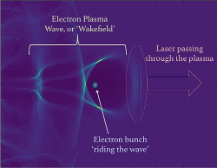Plasma-based Particle Acceleration
Contact Person: Chris Murphy
Image from:https://project-hl-lhc-industry.web.cern.ch
Conventional high-energy accelerators tend to be large and expensive devices due to the breakdown limit: If the strength of the accelerating gradient is two large, the material of the accelerator itself will become ionised, or ‘break down’. For this reason, the highest energy accelerators like the LHC at CERN (see left image) tend to be metres or, in this case, kilometres in length.
Using a plasma as the accelerating medium removes this break down limit allowing high energy particle beams to be accelerated over much shorter distances and in temporally shorter bunches. This is achieved by generating waves of plasma electrons on which short electron bunches can surf, gaining energy from the exceedingly strong electric fields which result. A simulation of this effect can be seen in the second image below.
Current experiments aim to use these electrons for industrial applications, like producing x-rays sources for port security, as well as fundamental science. Laser-plasma accelerated electrons are being used in experiments to test current models of strong field QED. Further information on strong field QED research can be found here

